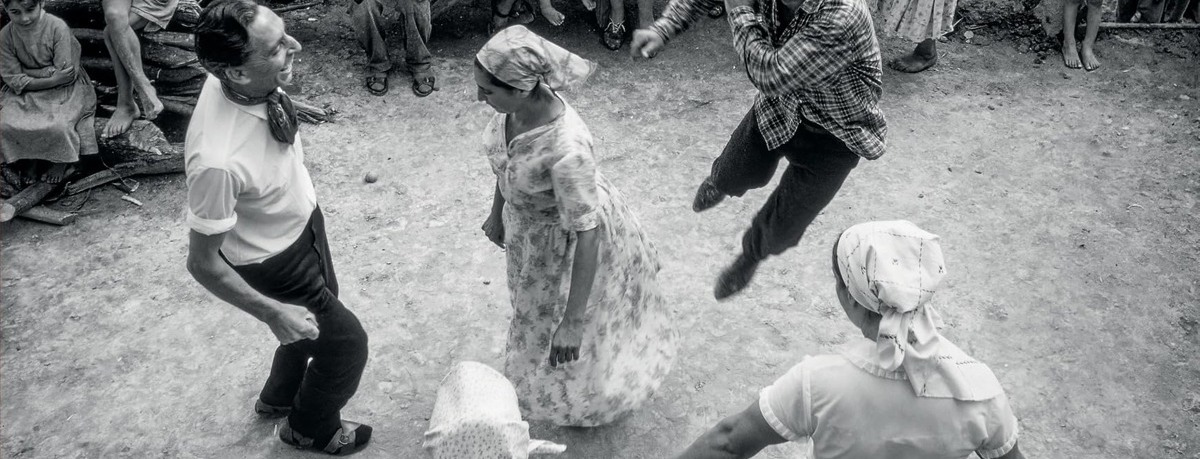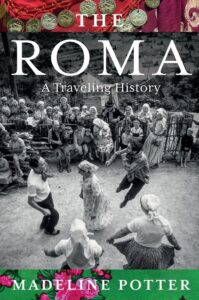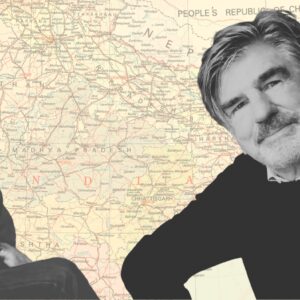
In From the Margins: On Letting the Roma Narrate Their Own Story
Madeline Potter Explores the Development of Romani Culture and Identity Across Europe
From a very young age I was drawn to the world of fiction. Every day my grandfather would walk me home from nursery and tell me a story as we walked along the lifeless streets. I wish I could remember them all in more detail. I recall one story about a family of Christmas trees who dreaded being felled and separated, so they tried to make themselves look unappealing. There was another about a man on horseback trying to pick cherries from a tree but forgetting to tell his horse to stop, so he’d miss the branches all the time. There were variations on better-known tales, such as “Thumbelina,” which terrified a younger me.
At home, I would spend much of my time reading and daydreaming about traveling to strange lands, from the Mississippi Delta of Tom Sawyer and Huckleberry Finn to the Wonderland of Lewis Carroll’s ‘Alice’ books. I dreamed of traveling, but neither I nor the other Romani children I grew up with were aware that our community had not that long ago been nomadic.
I suppose I wasn’t your typical reader, a bookworm hidden away in a magical world of their own. But reading was only the next best thing to storytelling: what I really loved was passing the stories I read on to others. So I told them to the other Romani children on the block, as we sat down and chugged cold water after running around in the hot sun. I didn’t realize at the time that for me reading and storytelling were all about forging connections, about coming together as a community. When I became a scholar of literature, I discovered a new world of reading: a world where people retreated away from society to read in silence and solitude, tucked away cosily in their studies; and where books were praised and valued as wonderful objects to possess but not to be shared. I realized that I could never fit into that world. I craved the oral tradition of storytelling, its communal feeling. I loved the act of reading together with others: reading stories out loud to each other, laughing and crying and screeching away in horror at a scary tale; and learning who we are by trying to make sense of these tales. Though I didn’t know it then, I now think that it was the Romani way surviving inside me, at a time when silence and shame enveloped everything related to Romani culture.
As I began to embrace and celebrate Romani culture and history as an adult, I came to realize that an inkling of that ancestral traveling lifestyle may have survived within me.
When I was a child in 1990s Romania, there wasn’t much talk of Romani history. There were the legends and the ghost stories. There were tales of travelers setting up camp on cursed ground and being protected from demons by a faithful dog. There was the story of the Romani musician who, having played music for three days and nights, fell off his horse-drawn carriage in a state of complete exhaustion. There was the legend that told how, when God shared His gifts with the nations of the world, the Roma arrived late and so were given the whole earth to wander instead. But these tales seemed as distant to me as the stories of Alice or the Three Musketeers.
It was only when I was in my twenties that I began to discover Romani history and saw how it was intertwined with the story of my own family. There was displacement and trauma in my family background, especially when it came to the Second World War. There were things I knew, things I suspected, and things that weren’t talked about. Some of my relatives, who were living in Eastern Slovakia at the time, were sent to Dachau. Some survived; others didn’t. Other relatives had been deported from Romania to Transnistria. When I looked at their names in an online Holocaust archive, the past suddenly became very real. I stared at their names on a list of nomadic Romani people who had been rounded up and deported, my great-aunt just a name on a record, and the horror pierced me. I wished I could have known her, learned about her life.
But there was something else that struck me at that moment, something that I had never thought about before. My great-aunt, and other family members, had still been nomadic. All of a sudden, Romani history came to life for me, and it was personal. It wasn’t that long ago and, if things had gone differently—if the Roma hadn’t been racially persecuted during the Second World War, if the post-war communist regime hadn’t forced Romani travelers to settle—maybe I too would have lived the nomadic life. It felt at once close and yet so remote.
The loss of the nomadic tradition completely transformed Romani communities as well as their identity in Romania. Instead of traveling in their vardos, the Roma started living in houses, some of them intricately designed and resembling palaces. Whereas in the old traveling days they would sing songs and dance in their stopping places, surrounded by horses and carriages, these celebrations now happened in the backyards of tenement blocks during long sweltering days. But what amazes me most is how quickly we forgot about our past. Despite the stories of traveling I had heard when I was growing up, I never connected the present to a lost past. I never sat down to ponder how the past had shaped present-day Romani communities, or how our own story intersected with that of those Romani groups that still practiced the nomadic tradition.
And of course, in the 1990s, there was so much else to grapple with, for both the Roma and the non-Roma. A bloody revolution in 1989 was followed by economic strain, and poverty and diseases affected Romani communities in particular. Some continued to practice traditional crafts, others turned to begging; yet others seemed to carry on as if nothing had changed. In families and across communities, memories of the traveling life gradually wasted away. Especially among children and teenagers, no one spoke of it.
Yet as I began to embrace and celebrate Romani culture and history as an adult, I came to realize that an inkling of that ancestral traveling lifestyle may have survived within me. It seems to be in my blood, coursing through my veins, framing the way I see the world. I have noticed that my memory is strangely place-bound: I don’t often remember when something happened but rather where it occurred. Time is often blurry for me but places are always sharp and vivid. It’s as if my memories are a train carriage, racing through the places that I’ve travelled to and stopped in, places that have shaped me in a good way and others that have traumatized me. For me, this traveling memory reflects the Romani experience and history: of how, in moving from place to place, we’ve been transformed by them; but also of how we’ve been marginalized, castigated and driven from our stopping places, ever since we departed our ancestral homeland.
*
We left India probably some 1,500 years ago. I say “we left” with a familiarity that suggests intimacy, and as if it happened yesterday; but I feel peculiarly connected to my ancestors, however many years there are between us. Romani legends offer different explanations of our origins. There are the ones that say the Roma came from Egypt, and others that think they’re the lost tribes of Israel. I never really paid much attention to these claims until, one day, my grandfather told me that in fact the Roma had come from India. I didn’t explore it any further at the time, but in my adult years, that connection made more and more sense. And I started wondering why the Roma had left India—perhaps, as a people who have faced persecution throughout history, they thought they’d be better off somewhere else. I also wanted to know what had happened after they left India, and how they ended up in so many different places. Most of all, I wanted to know where I might fit into this history.
For many Roma, our histories and stories are entwined across time and place. We are heterogeneous, with many subgroups—there is the natsya and, within it, the vitsas or vitsi—each with our own customs and traditions. There are the Romanichal Travelers, found in the United Kingdom, but also in other English-speaking countries like Australia and Canada, and whose language, Anglo-Romani, blends elements of the two cultures. There are the Sinti of Central Europe and Germany, and the Calé of the Iberian peninsula. Then there is my own vitsa, part of the Kalderash group, spread widely throughout the Balkans. The Roma are often described as an ethnic minority, but many Romani communities view “Roma” as a broad racial identity, stretching all the way back to our Indian ancestry. Indeed, to look at the Roma as one ethnicity is to disregard the veritable mosaic of Romani subgroups. There’s a thread that holds us all together, which to me feels like a string of fairy lights scattered across the world. Each of these lights shines with its own unique beauty.
In the Romani language, which is descended from Sanskrit, the term “Rom” means “man” or “husband.” Despite a popular belief that “Roma” refers to the Roma from Eastern Europe and “Romani” to those groups found in Britain, it is simply a plural noun, and “Romani” an adjective. Not all Romani subgroups use the same terms to self-identify, and the Romani language, or Romanes, is split into numerous dialects. Yet despite this diffusion and heterogeneity, our histories remain inextricably interlaced. And it is the history of our experiences, culture and traditions that has shaped present-day Romani identity. Yet there is another, darker side to our story. Over the centuries, we have shared, individually and collectively, the experience of hatred and persecution.
*
An important part of this marginalization and persecution is the consistent erasure of Romani history. Across Europe, there is little understanding of the Romani past, even though the Roma have lived here for so long. Little is known about their enslavement, about repeated attempts to destroy their culture, and about the Porrajmos, or Samudaripen, as the Romani Holocaust is known. The Roma and their history are consistently overlooked and forgotten. This silence is part of the racism we suffer, and it has real-life consequences too. It means that many Roma growing up today are left disconnected from their culture and history. To be out of tune with your identity and history is to be defenseless in the face of racism. It’s a paralyzing experience, one that I myself have endured at various points, particularly when I first arrived in Britain as a young adult.
At that time I felt confused about my identity, unsure of myself and frightened of being Romani. I remember one occasion, on a plane to Heathrow, when the woman next to me asked, “What are you?” Her dehumanizing tone, reducing me to a flattened “what,” jolted me from my drowsy reverie. I have thought about that question many times since. It stands out, not only because I’ve heard it over and over in the intervening years, but because it is representative of what many racialized people experience: she was prying as well as being cutting.
I quickly came to realize that in Britain I was more ethnically ambiguous than I would be anywhere in Eastern Europe. There, where there is little immigration, the Roma are clearly visible, so anyone of a slightly darker complexion is presumed, often wrongly, to be Romani. I’ve seen British Asians being mistaken for Roma in Bucharest, incurring the racist slurs and wrath that my people have to put up with on a daily basis. Britain’s diversity meant that I could more easily blend in; that I would not instantly be clocked as Romani. Yet this has also meant that it has become easier to forget my roots.
In Britain, both in the public mind and in official policies, the Roma were synonymous with “Travellers.” There was little awareness that we had Indian roots, that there was a Romani language related to Hindi, and that many of us lived in Eastern and Central Europe. When I told people I was Roma, they often asked whether I’d grown up in a caravan. The idea that in Romania some communities had been settled for centuries seemed incomprehensible. I saw that there was little understanding of the rich tapestry of Romani history and life. Everyone I spoke to had a fixed idea about what a Rom or a “Gypsy” was. Yet there are many ways of being Roma.
In the UK, many Romani communities have mixed with Irish Travellers and local populations, while across Central and Eastern Europe, the Roma are what we often call a “visible minority.” But in the UK, British Romanies and Central and Eastern European Roma are all collapsed into a single entity: a homogeneous and essentially empty perception labelled “Gypsies.” As an Eastern European Romni in Britain, I found it difficult to figure out where I belonged—and I didn’t want the confusion to follow me around. I longed to feel safe and be visible within my Romani identity; and I wanted to celebrate my culture.
*
One thing that has sustained me for all this time is my love of reading and storytelling. When I studied English at university, I was particularly drawn to how things that are tragic and monstrous can help us understand something about ourselves as humans. So I decided to explore this further and embarked on a PhD in English literature. During my first year at the University of York, I lived in student accommodation. Struggling to motivate myself and often feeling alone, I took up long-distance running to introduce discipline into my life and to clear my head.
On these runs, I was loath to stop. I dreaded zebra crossings and the city-center pavements, and instead ran into the surrounding countryside, abandoning myself to the endless roads that seemed to be going nowhere. One morning I left early on a long run into the crisp chill of an autumn day. A few miles in, I saw caravans parked in a field, where some Travellers had set up their camp. The sight of those caravans literally stopped me in my tracks. I felt so removed from them, even though they were only meters away. I thought of how, only a few generations back, some Romani communities in Romania had still enjoyed the nomadic lifestyle that had now been irrevocably lost. As I stood there, motionless, my arms and legs became covered in goosebumps. The air was biting and I could see my breath. I continued to stare, dumbfounded, at the camp. I’d seen caravans before, of course. But seeing them lined up in the field, and hearing the sound of children playing with a little dog, I realized that the traditional Romani way of life was still alive. Yet what hit me viscerally that morning was that I would never experience it myself.
I’m not sure how you can mourn something you’ve never had, but, in that moment, I mourned the history that had been ripped away from me. I felt a strange sense of belonging to a past from which I had been cut off, and I felt somehow proud of a history that didn’t really feel as if it was mine. There was also anger inside me at the thought that centuries of persecution had forced the Roma across Europe to abandon their traditional lives. I also felt angry because this was exactly what the recent Police Act was attempting to do to the Roma in the UK.
*
The Roma occupy an almost mythical space within the collective imagination of Europe—somewhere between “fascination and fear,” as Klaus-Michael Bogdal has put it in his historical study. For many today, the word “Roma” conjures images of free-spirited nomads, creative and carefree people who live on the road, refusing to obey society’s norms and choosing personal freedom instead. What they tend to ignore is the long, difficult history of being harassed, expelled, deported, demonized, enslaved and killed. They imagine the traveling but not the hardship; they embrace the fashion but rarely recognize the tradition, and in so doing they create glamour out of real pain. The Roma’s history and their present-day challenges remain broadly underreported and often misunderstood.
I felt a strange sense of belonging to a past from which I had been cut off, and I felt somehow proud of a history that didn’t really feel as if it was mine.
There is no written account of our migration westwards from the territory of present-day Rajasthan in India, and there are no exact dates, but many historians agree that it probably happened during the sixth or seventh century. Others contend that we might have left later, during the eleventh century, as a result of Sultan Mahmud Ghaznavi’s invasion of north India. Some studies have suggested that the Roma could be descended from the Dalits, the “untouchables,” and so another theory postulates that they left to be free of the Hindu caste system. Whatever the reasons for our initial departure, they have been lost in the mists of time. As a result, our identity has been created on the road.
In his epic Shahnameh—”The Book of Kings”—completed in 1010, the Persian poet Ferdowsi mentioned a people who arrived as musicians at the court of the Persian king from India. Ferdowsi relates the legend of King Bahram Gor who, upon hearing that the poor in his country had to drink their wine in silence because they could not afford music, decided to rectify this injustice. He sent word to the King of India, who provided him with ten thousand “Gypsy” musicians to entertain the poor. The Persian king gave each of them an ox, a donkey and some seed corn, in the hope that they would use these gifts to become farmers, while continuing to entertain people with their lute music. But these “Gypsies” decided instead to eat the oxen and the wheat. This made the king so angry that he ordered them to pack their instruments and belongings onto the backs of their donkeys and go roaming the world. Condemned to a life of eternal wandering, they would be forever nomads.
This legend has long been associated with the Roma, and indeed historians have found accounts of immigration from northern India into Persia around the time of the epic’s composition. While the reconstruction of the early history of the Roma from these historical and literary snippets remains speculative, all these theories do seem to suggest that the nomadic lifestyle grew out of necessity. Yet this lack of choice, as well as the prejudice and persecution the Roma endured when they entered Europe, is often conveniently forgotten by those who romanticize the Romani lifestyle. I’ve heard some people describe the Roma as early hippies; I’ve heard others talk about us as if they were describing elves or other mythological creatures.
Depictions of Romani life in films and books rely heavily on that aura of mystery, and portray mystical practices like palmistry and tarot reading. We’ve all seen TV shows or movies in which a Romani woman (no doubt portrayed by a non-Romani actor) gazes wisely into a crystal ball or dashes out a curse. In a recent conversation on social media, I tried to explain how such stereotypes result in people receiving abuse, or even being killed—as happened to Stanislav Tomáš, a Czech Rom who died in Teplice in 2021 when a police officer kneeled on his neck, in a case heartbreakingly reminiscent of George Floyd’s murder in the US. In reply, a woman who had built a caravan in her garden and proudly talked about her “Gypsy skirt” collection, accused me of shattering her cherished image of the Roma as a “wild people”—shattering it, that is, with real life stories of racism and persecution.
I’ve noticed with sadness how, even in anti-racist debate, the Roma are often forgotten or left out. Romani applicants have been excluded from scholarships and prizes intended to support people of color, because “Roma” had been taken to mean simply “white traveller,” and because governmental policies have not got to grips with terminology and identity. There are many other such instances that reveal a complete lack of knowledge of who we are, of our history and of the challenges we face in our daily lives. From Disney’s representation of Victor Hugo’s Esmeralda to white women dressing up as “Gypsies” for Halloween, our identity and culture are mystified and misrepresented. Growing up, I wished for complex, realistic Romani characters in books, films and games, characters imagined fully as human beings. When I was a little girl in Romania, there were no role models who looked like me. Without proper Romani representation, illusions and inaccuracies will continue to proliferate, denying us our voices and leaving us open, individually and as a community, to being stereotyped. But how can we find the courage and means to speak up and tell our own story?
__________________________________

From The Roma: A Traveling History by Madeline Potter. Copyright © 2025 by Madeline Potter. Reprinted courtesy of Harper, an imprint of HarperCollins. Available wherever books are sold.
Madeline Potter
Madeline Potter was born in Romania in 1989 and grew up Romani in post-Communist Romania. A scholar of nineteenth-century literature, she earned a PhD in English Literature from the University of York in 2020. She currently works as an early career teaching and research fellow at the University of Edinburgh.












